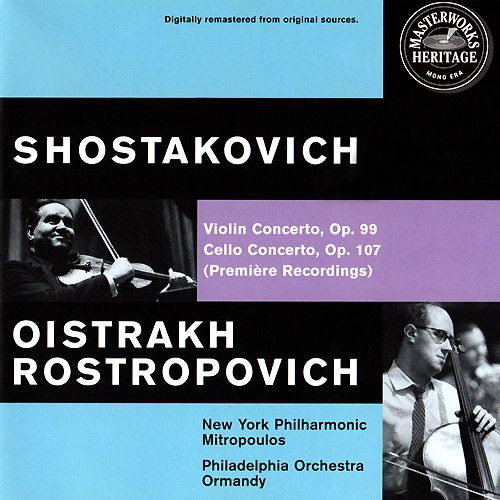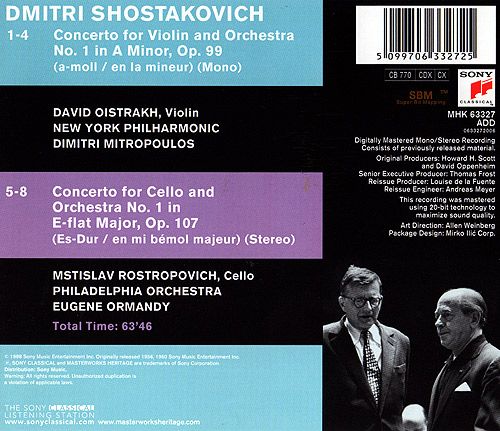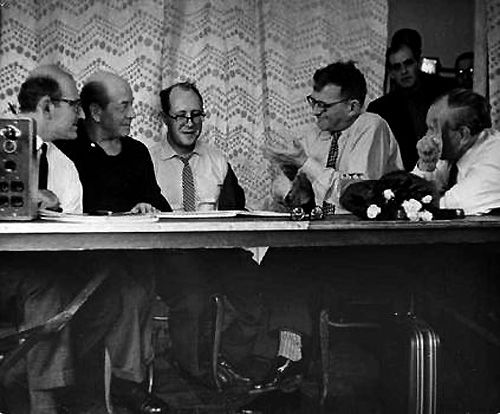wimpel69
11-30-2014, 02:30 PM
EAC-FLAC link below. This is my own rip. Complete artwork,
LOG and CUE files included. Do not share. Buy the original!
Please leave a "Like" or "Thank you" if you enjoyed this!
As many know, Dmitri Shostakovich wrote two violin concertos. But his work list suggests two
separate versions of the First, the Op. 77 and the Op. 99. The Violin Concerto No.1 was originally
completed in 1948, but withheld for seven years by the composer, owing to the oppressive climate
for artists in the Soviet Union at the time. Any new work might have drawn the wrath of Stalin and
his cronies in the arts. Shostakovich returned to the score in 1955 and then assigned the higher opus
number to it. Actually, the only documented change he made came not as a result of second
thoughts, but as a matter of consideration for the soloist. During rehearsals in 1955, the virtuoso
violinist David Oistrakh requested of Shostakovich that the opening statement of the fourth
movement's main theme be given to the orchestra, so that the soloist could take a rest following
the long cadenza which leads right into the finale, and Shostakovich agreed to make the change.
The First Violin Concerto begins as a dark work, full of that gloom and dread that pervade so many
of Shostakovich's serious works. The first movement Nocturne starts off with an ominous theme
that is both inwardly reflective and filled with foreboding. Midway through, a thinly veiled Dies
Irae appears as the music becomes more tense. Yet, a climactic release never quite arrives and
the suggested conflicts remain unresolved. The second movement is a rather diabolical Scherzo
that contains some interesting allusions, first to the third movement of the Tenth Symphony
(1953) and later to the first movement of the Second Piano Concerto (1957). The violin and
woodwinds scurry about to deliver the playful yet menacing material, but gradually the character
of the movement becomes more sarcastic, eventually breaking into a hallucinatory folk dance.
The latter part of the Scherzo sounds less acidic, the diabolic and sarcastic elements surrender
to the driving, insistent energy. The third movement is a Passacaglia that has a chorale-like
quality at the outset, as the woodwinds deliver a mournful theme. The violin enters playing
the main theme, one of the composer's loveliest and warmest creations. Shostakovich's 1943
Eighth Symphony's fourth movement also featured a passacaglia, though of a decidedly
grimmer character. Here, there is tension, but also much beauty. The latter third of the
movement is taken up by a brilliant cadenza, which leads directly into the brief finale, a
Burlesque of a mostly festive nature. The mood is similar to that of the faster music in the
Tenth Symphony's finale, though there are no clear thematic references. While the work
ends triumphantly, its manic qualities suggest a discomfort by the composer, as though the
happy resolution might have been disingenuous.
Shostakovich eliminated trumpets and trombones from the orchestration of this Concerto,
and his writing is otherwise sensitive to the limited tone of a solo violin playing amid a
large ensemble. A typical performance of this work lasts about 35 minutes.
Shostakovich composed the Cello Concerto No.1 in July 1959 and Mstislav Rostropovich
introduced it at Leningrad on October 4, with Yevgeny Mravinsky conducting. It is lightly scored
for double winds, piccolo, contrabassoon, a single horn (no other brass), timpani, celesta,
and strings.
Although a prolific composer in other forms, Shostakovich wrote only six concertos. If those
for keyboard seem prevailingly saucy and sun dappled, the four string concertos are somberly
serious. Where there's any laughter at all, it sounds forced and hollow. To lighten it (or try)
only reinforces the "holy fool" (yurodivy) analogy that haunts Solomon Volkov's Testimony,
the posthumously alleged Memoirs of Dmitri Shostakovich.
When the First Cello Concerto was written with almost Mozartean speed, Stalin had been
dead six years but not forgotten. In 1958 Boris Pasternak was forced to decline a Nobel
Prize for his anti-Stalinist novel, Doctor Zhivago, and then was expelled from the Writers'
Union. Ian MacDonald, in The New Shostakovich, concluded that Pasternak's humiliation
and subsequent persecution significantly influenced the First Cello Concerto. Volkov, on
the other hand, gave no hint, nor did Elizabeth Wilson in A Life Remembered. Most of
what she included, anent the concerto, was Rostropovich's celebration of himself, with
this notable exception: "In the First Cello Concerto [M.R. speaking], Shostakovich
alludes to Stalin's favorite song, 'Suliko.' These allusions are undoubtedly not accidental,
but...are camouflaged so craftily that even I didn't notice them to begin with. The first
time Dmitry Dmitriyevich hummed this passage through to me [from the concluding
rondo movement], he laughed and said, 'Slava, have you noticed?'"
Cello Concerto No. 1 is a major-key work in minor keys more often than not, recalling
the mature Schubert's subtle modulations. It was his first large-scale undertaking
after the Eleventh Symphony a year earlier and one of the works he quoted in
his autobiographical Eighth String Quartet of 1960.

Music Composed by
Dmitri Shostakovich
Played by the
New York Philharmonic Orchestra
The Philadelphia Orchestra
With
David Oistrakh (violin)
Mstislav Rostropovich (cello)
Conducted by
Dmitri Mitropoulos
Eugene Ormandy
Recorded in the presence of the composer.

"Shostakovich had the great good fortune to write for Russia’s finest soloists, who also
happened to be the among world’s best. David Oistrakh remade the First Violin Concerto
with the composer’s son on the podium (EMI), but he never bettered this singularly
intense performance from 1956, captured in excellent mono sound. Mitropoulos had
a particular gift for contemporary music, especially of the nervous and twitchy sort,
and that describes the Shostakovich to a tee, at least in the quick movements. That
said, the pungent spikiness of the scherzo and finale, yield to this noble but always
propulsive account of the great third movement passacaglia, followed immediately by
Oistrakh’s alternately probing and brilliant cadenza.
The same qualities of idiomatic musical ownership describe Rostropovich’s first
official recording of the First Cello Concerto, which was supervised by the composer
in Philadelphia right after the work’s U.S. premiere. One of the more striking aspects
of this performance is the moderate tempo of the opening movement. It makes us
realize just how dependent on the actual sound of the cello the music really is, and
how much confidence Shostakovich placed in Rostropovich, who pours out the
tone unstintingly and quite literally sustains the entire movement. The expressive
power he brings the second subject is unforgettable, but he follows it up with a
gorgeous account of the slow movement and a cadenza and finale that remain
points of reference for all future performances. Ormandy and the Philadelphia
provide accompaniments that amazed the composer, as they should us as well."
Classics Today http://i8.photobucket.com/albums/a29/wombat65/p10s10_zps3686a401.gif

Download Link - https://mega.co.nz/#!rYJChLRQ!q2mfvcqG8xEOEG4adLvP2uSN5-5VWzOgClbGxUJggnQ
Source: Sony CD, 1998 (my rip!)
Format: FLAC(RAR), ADD Stereo, Level: -5
File Size: 357 MB (incl. artwork, booklet, log & cue)
Enjoy! Don't share! Buy the origina! Please leave a "Like" or "Thank you" if you enjoyed this! :)
LOG and CUE files included. Do not share. Buy the original!
Please leave a "Like" or "Thank you" if you enjoyed this!
As many know, Dmitri Shostakovich wrote two violin concertos. But his work list suggests two
separate versions of the First, the Op. 77 and the Op. 99. The Violin Concerto No.1 was originally
completed in 1948, but withheld for seven years by the composer, owing to the oppressive climate
for artists in the Soviet Union at the time. Any new work might have drawn the wrath of Stalin and
his cronies in the arts. Shostakovich returned to the score in 1955 and then assigned the higher opus
number to it. Actually, the only documented change he made came not as a result of second
thoughts, but as a matter of consideration for the soloist. During rehearsals in 1955, the virtuoso
violinist David Oistrakh requested of Shostakovich that the opening statement of the fourth
movement's main theme be given to the orchestra, so that the soloist could take a rest following
the long cadenza which leads right into the finale, and Shostakovich agreed to make the change.
The First Violin Concerto begins as a dark work, full of that gloom and dread that pervade so many
of Shostakovich's serious works. The first movement Nocturne starts off with an ominous theme
that is both inwardly reflective and filled with foreboding. Midway through, a thinly veiled Dies
Irae appears as the music becomes more tense. Yet, a climactic release never quite arrives and
the suggested conflicts remain unresolved. The second movement is a rather diabolical Scherzo
that contains some interesting allusions, first to the third movement of the Tenth Symphony
(1953) and later to the first movement of the Second Piano Concerto (1957). The violin and
woodwinds scurry about to deliver the playful yet menacing material, but gradually the character
of the movement becomes more sarcastic, eventually breaking into a hallucinatory folk dance.
The latter part of the Scherzo sounds less acidic, the diabolic and sarcastic elements surrender
to the driving, insistent energy. The third movement is a Passacaglia that has a chorale-like
quality at the outset, as the woodwinds deliver a mournful theme. The violin enters playing
the main theme, one of the composer's loveliest and warmest creations. Shostakovich's 1943
Eighth Symphony's fourth movement also featured a passacaglia, though of a decidedly
grimmer character. Here, there is tension, but also much beauty. The latter third of the
movement is taken up by a brilliant cadenza, which leads directly into the brief finale, a
Burlesque of a mostly festive nature. The mood is similar to that of the faster music in the
Tenth Symphony's finale, though there are no clear thematic references. While the work
ends triumphantly, its manic qualities suggest a discomfort by the composer, as though the
happy resolution might have been disingenuous.
Shostakovich eliminated trumpets and trombones from the orchestration of this Concerto,
and his writing is otherwise sensitive to the limited tone of a solo violin playing amid a
large ensemble. A typical performance of this work lasts about 35 minutes.
Shostakovich composed the Cello Concerto No.1 in July 1959 and Mstislav Rostropovich
introduced it at Leningrad on October 4, with Yevgeny Mravinsky conducting. It is lightly scored
for double winds, piccolo, contrabassoon, a single horn (no other brass), timpani, celesta,
and strings.
Although a prolific composer in other forms, Shostakovich wrote only six concertos. If those
for keyboard seem prevailingly saucy and sun dappled, the four string concertos are somberly
serious. Where there's any laughter at all, it sounds forced and hollow. To lighten it (or try)
only reinforces the "holy fool" (yurodivy) analogy that haunts Solomon Volkov's Testimony,
the posthumously alleged Memoirs of Dmitri Shostakovich.
When the First Cello Concerto was written with almost Mozartean speed, Stalin had been
dead six years but not forgotten. In 1958 Boris Pasternak was forced to decline a Nobel
Prize for his anti-Stalinist novel, Doctor Zhivago, and then was expelled from the Writers'
Union. Ian MacDonald, in The New Shostakovich, concluded that Pasternak's humiliation
and subsequent persecution significantly influenced the First Cello Concerto. Volkov, on
the other hand, gave no hint, nor did Elizabeth Wilson in A Life Remembered. Most of
what she included, anent the concerto, was Rostropovich's celebration of himself, with
this notable exception: "In the First Cello Concerto [M.R. speaking], Shostakovich
alludes to Stalin's favorite song, 'Suliko.' These allusions are undoubtedly not accidental,
but...are camouflaged so craftily that even I didn't notice them to begin with. The first
time Dmitry Dmitriyevich hummed this passage through to me [from the concluding
rondo movement], he laughed and said, 'Slava, have you noticed?'"
Cello Concerto No. 1 is a major-key work in minor keys more often than not, recalling
the mature Schubert's subtle modulations. It was his first large-scale undertaking
after the Eleventh Symphony a year earlier and one of the works he quoted in
his autobiographical Eighth String Quartet of 1960.

Music Composed by
Dmitri Shostakovich
Played by the
New York Philharmonic Orchestra
The Philadelphia Orchestra
With
David Oistrakh (violin)
Mstislav Rostropovich (cello)
Conducted by
Dmitri Mitropoulos
Eugene Ormandy
Recorded in the presence of the composer.

"Shostakovich had the great good fortune to write for Russia’s finest soloists, who also
happened to be the among world’s best. David Oistrakh remade the First Violin Concerto
with the composer’s son on the podium (EMI), but he never bettered this singularly
intense performance from 1956, captured in excellent mono sound. Mitropoulos had
a particular gift for contemporary music, especially of the nervous and twitchy sort,
and that describes the Shostakovich to a tee, at least in the quick movements. That
said, the pungent spikiness of the scherzo and finale, yield to this noble but always
propulsive account of the great third movement passacaglia, followed immediately by
Oistrakh’s alternately probing and brilliant cadenza.
The same qualities of idiomatic musical ownership describe Rostropovich’s first
official recording of the First Cello Concerto, which was supervised by the composer
in Philadelphia right after the work’s U.S. premiere. One of the more striking aspects
of this performance is the moderate tempo of the opening movement. It makes us
realize just how dependent on the actual sound of the cello the music really is, and
how much confidence Shostakovich placed in Rostropovich, who pours out the
tone unstintingly and quite literally sustains the entire movement. The expressive
power he brings the second subject is unforgettable, but he follows it up with a
gorgeous account of the slow movement and a cadenza and finale that remain
points of reference for all future performances. Ormandy and the Philadelphia
provide accompaniments that amazed the composer, as they should us as well."
Classics Today http://i8.photobucket.com/albums/a29/wombat65/p10s10_zps3686a401.gif

Download Link - https://mega.co.nz/#!rYJChLRQ!q2mfvcqG8xEOEG4adLvP2uSN5-5VWzOgClbGxUJggnQ
Source: Sony CD, 1998 (my rip!)
Format: FLAC(RAR), ADD Stereo, Level: -5
File Size: 357 MB (incl. artwork, booklet, log & cue)
Enjoy! Don't share! Buy the origina! Please leave a "Like" or "Thank you" if you enjoyed this! :)